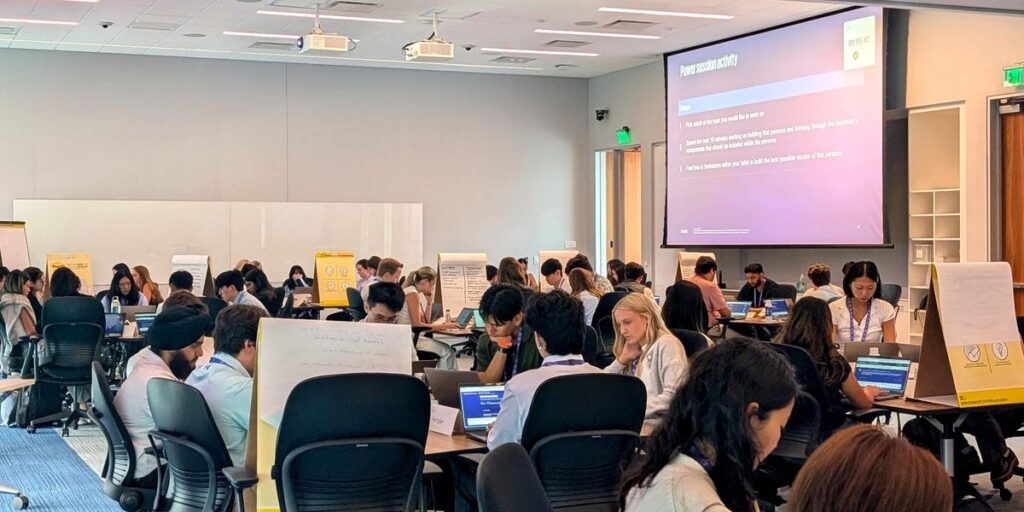On a sweaty Monday morning in June, I joined 90 KPMG tax interns in an air-conditioned classroom in Florida.
We were there for one reason: to learn how to use AI.
We gathered at Lakehouse, KPMG’s gleaming training facility in Lake Nona, Florida. I had been invited to spend two days at the facility as part of my ongoing reporting about AI and the consulting industry, and as the class had already started, I slipped in quietly and took a seat.
Given that KPMG helps some of the world’s biggest companies figure out how to use AI, I was curious to see how the consulting giant was teaching its own employees to use the technology.
My biggest takeaway? Upskilling for the AI era can be surprisingly basic.
The five ways of asking AI a question
Four large screens — two on each wall— hung down from the ceiling in the classroom, and the 90 interns sat around circular tables in groups of six.
Sherry Magee, a senior director at KPMG, told me during a tour of the property that the space was designed so there was no “front row of the classroom,” which she said encourages participation.
The training session was run by two KPMG employees. They opened with a question about the interns’ use of AI: “Who just generally goes straight to it and just starts typing?”
Pretty much everyone in the room raised a hand.
One of the instructors explained that instead of chatting with AI, there were five prompting techniques they could use to adjust the model’s response to get the “best, most relevant, and accurate output.”
The techniques are:
- Chunking: dividing a large prompt into smaller, more manageable requests
- Few-shot prompting: giving the AI a few examples to guide its response
- Iterative question refinement: repeatedly rephrasing or refining your questions to lead the AI to a more precise response
- Chain of thought prompting: asking AI to include a breakdown of how it has reached an answer
- Flipped interaction prompting: requesting that the AI ask you questions to prompt new thoughts
They work best for different tasks, the instructors explained. For example, a “chain of thought” prompt can be useful to get AI to show its work. This “thinking aloud” approach is more transparent and can be useful for tax professionals who need to check the results for inaccuracies.
“Flipped interaction” prompts could be used in a tax setting to prepare a client profile or to tailor advice.
The instructor told the interns that asking AI to prompt them with questions can be helpful for “making you think of things you don’t often think of yourself.”
Echoes from my journalism degree
The two-hour training session covered the foundations of KPMG’s AI tool for tax, the Digital Gateway. It also explained the concept of AI personas, introduced techniques to reduce hallucinations, and taught the interns KPMG’s key ethical principles to apply when using AI.
The interns were also taught how to provide AI tools with the right detail and tone for their target audience.
I’m no tax expert, but I am a journalist — and what struck me during the session is how much these teachings echoed the ones I was taught in journalism school. The success of an interview hinges on the quality of the questions I ask the other person. As KPMG stressed in its training sessions, by thinking about how you communicate information to an AI, you can also get the most helpful outcome from said AI.
“The more detail you give it, the more likely it is to predict the next thing correctly,” explained the instructor.
The intern training focused on admin-related examples of using AI, like drafting emails or creating slide decks. It wasn’t the most complicated or advanced stuff, but the session I attended was for summer interns in the tax division, so I wasn’t seeing how the firm’s leading technicians tackle AI.
More senior employees are using AI for industry research and preliminary audit memos, Becky Sproul, a KPMG audit partner, told me during an interview later that day.
They’re presenting AI with client documentation, auditing, and accounting standards, and asking it to write “a memo going through all the various attributes of the accounting standard,” she said.
That preliminary work can help get tax professionals “80% of the way there,” Sproul said.
The firm is also building AI agents where the “agent almost becomes like a team member,” and is using engagement metrics to encourage employees to use AI, she said.
The other Big Four firms — Deloitte, EY, and PwC — have also deployed agentic AI platforms this year, which they all present as being transformative for the workforce and productivity.
Teaching methods
The simple teaching methods used in the session were another reminder that while AI is complicated, learning how to use it doesn’t have to be.
The interns were learning about technology that is transforming workplaces, but they were still using large cardboard flipboards to share their ideas.
The session had one extra reminder for workers in the AI age: Take a break from your screen.
At one point, an employee from the Lakehouse’s “stretch” team, its on-site gym, ran into the center of the room and announced he was there to lead them through a “wellness break,” which entailed five minutes of stretching and breathwork accompanied by relaxing music.
The interns stood up with bemused expressions, but soon the whole class was loosening up, which the instructor told them would help them stay focused.
“This is what we signed up for, right?” I heard one intern joke as he lunged forward.
Choosing to prioritize my reporting over a relaxing stretch, I didn’t join in.
Have a tip? Contact this reporter via email at pthompson@businessinsider.com or Signal at Polly_Thompson.89. Use a personal email address and a nonwork device; here’s our guide to sharing information securely.
Read the full article here


